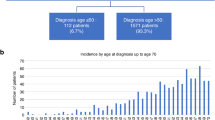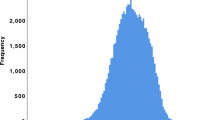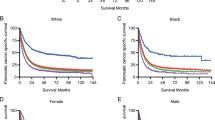Summary
Background. Pancreatic cancer is predominantly a disorder of the elderly population in the United States. In Egypt, the disease has traditionally been considered rare, and there has not been a previous publication on its population-based incidence or age distribution.
Methods. We reviewed the records of 728 pancreatic cancer patients seen at the Gastrointestinal Surgery Center of Mansoura University in the East Nile Delta region of Egypt between 1995 and 2000. We computed population-based, age-specific, and age-adjusted incidence rates in this population and compared them with US incidence rates from the Epidemiology Surveillance and End Results (SEER) Program. We also analyzed clinical characteristics of the patients, as well as their surgical and medical management.
Results. Approximately one-fourth of all patients were under age 50. The mean ages of patients who had undergone Whipple’s resection, other surgical procedures, and no surgical procedure were 52.9 ± 11.6, 54.11 ± 10.5, and 55.1 ± 14.1 yr, with no statistically significant differences. Age-adjusted incidence rates were higher in Egyptian patients than in US patients under age 65 (7.1/100,000 vs 3.3/100,000) but were much higher in US patients than in Egyptian patients over age 65 (6.6/100,000 vs 59.1/100,000). Clinical management did not differ between patients under and over age 50.
Conclusion. The population in the East Nile Delta region of Egypt exhibits an unusually high rate of young-onset pancreatic cancer. Further studies to investigate the epidemiology of pancreatic cancer in this population may provide clues to its etiology.
Similar content being viewed by others
References
Anonymous. Cancer Facts and Figures. Annual report published by American Cancer Society, Atlanta, Georgia, 2000, pp. 15–16.
Lowenfels AB, Maisonneuve P. Pancreatic cancer: development of a unifying etiologic concept. Ann N Y Acad Sci 1999;880:191–200.
Mokhtar N. Digestive tumors: In: Cancer pathology registry (1985–1989). The National Cancer Institute of Cairo University, Nadia Mokhtar (ed) Published by The National Cancer Institute, Cairo, 1991, pp. 36–37.
Sherif M, Ibrahim AS (eds). Cancer Registry of Metropolitan Cairo: The Profile of Cancer in Egypt (1972–1987), The National Cancer Institute, Cairo, 1987.
Parkin DM, Muir CS, Whelan SL, Gao YT, Ferlay J, Powell J (eds). Cancer incidence in five continents, IARC Scientific Publ, Lyon, France, 1992, No. 120, 182–185.
Isbister W. Colorectal cancer below age 40 in the Kingdom of Saudi Arabia. Aust N Z J Surg 1992;62:468–472.
Soliman AS, Bondy ML, Levin B, Hamza MR, Ismail K, Ismail S, et al. Colorectal cancer in Egyptian patients under 40 years of age. Int J Cancer 1997;71:26–30.
Kahan E, Ibrahim AS, Al-Najjar K, et al. Cancer patterns in the Middle East-special report from the Middle East Cancer Society. Acta Oncol 1997;36:631–636.
Soliman AS, Bondy ML, El-Badawy SA, Contrasting molecular pathology of colorectal cancer in Egyptian and western patients Br J Cancer 2001;85:1037–1046.
Soliman AS, Smith MA, Cooper SP, et al. Serum organochlorine pesticide levels in patients with colorectal cancer in Egypt. Arch Environ Health 1997;52:409–415.
Soliman AS, Bondy ML, Guan Y, et al. Reduced expression of mismatch repair genes in colorectal cancer patients in Egypt. Int J Oncol 1998;12:1315–1319.
Abdel-Rahman SZ, Soliman AS, Bondy ML, et al. Inheritence of the 194Trp and the 399Gln variant alleles of the DNA repair gene XRCC1 are associated with increased risk of early-onset colorectal carcinoma in Egypt. Cancer Lett 2000;159:79–86.
Statistical Year Book of the Arab Republic of Egypt 1952–1993. Published by the Central Agency for Public Mobilization and Statistics. Cairo, Egypt, 1994. Abdel-Azeem FS (eds) pp. 32–34.
Soliman AS, Bondy ML, Raouf AA, Makram MA, Johnston DA, Levin B. Cancer mortality in Menofeia, Egypt: comparison with U.S. mortality rates. Cancer Causes Control 1999;10:349–354.
National Cancer Institute. Surveillance, Epidemiology, and End Results. Cancer Statistics Review, 1973–1995 US Populations, Bethesda, MD, 1998, Web URL: www-seer.ims.nci.nih.gov/.
Miller BA, Silverman DT, Kaplan R. Pancreas. SEER Cancer Statistics Review 1973–1990. National Cancer Institute, Department of Health and Human Services, Pub No. 93–2789, Bethesda, MD pp. XXI.1.
Glazzer G, Coulter C, Crofton ME, et al. Controversial issue in the management of pancreatic cancer: part one. A debate held at St. Mary’s Hospital, London on 18 November 1993. Ann R Coll Surg Engl 1995;77:111–122.
Glazzer G, Coulter C, Crofton ME, et al. Controversial issue in the management of pancreatic cancer: part two. A debate held at St. Mary’s Hospital, London on 18 November 1993. Ann R Coll Surg Engl 1995;77:174–180.
Miller BA, Kolonel LN, Bernstein L, Young, Jr. JL, Swanson GM, West D, Kay CR, Liff JM, Glover CS, Alexander GA, et al., (eds). Racial/ethnic patterns of cancer in the United States 1988–1992, pp. 104–107. National Cancer Institute. NIH pub. No. 96–4104. Bethesda, MD, 1996.
Lowenfels AB, Maisonneuve P. Pancreatico-biliary malignancy: prevalence and risk factors. Ann Oncol (10 Suppl) 1999;4:S1-S4.
Doll R, Peto R, Wheatley K, et al. Mortality in relation to smoking: 40 years observation on male British doctors. BMJ 1994;11:309–311.
Howe GR, Jain M, Burch JD, et al. Cigarette smoking and cancer of the pancreas: evidence from a population-based case-control study in Toronto, Canada. Int J Cancer 1991;47:323–328.
Lowenfels AB, Maisonneuve P, Cavallini G et al. Pancreatitis and the risk of pancreatic cancer. International Pancreatic Study Group. N Engl J Med 1993;328:1433–1437.
Brand RE, Lynch HT. Hereditary pancreatic adenocarcinoma. Med Clin North Am 2000;84:665–675.
Flanders TY, Foulkes WD. Pancreatitis adenocarcinoma: epidemiology and genetics. J Med Genet 1996;33:889–898.
Lowenfels AB, Maisonneuve P, DiMagno EP, et al. Hereditary pancreatitis and the risk of pancreatic cancer. International Hereditary Pancreatitis Study Group. J Natl Cancer Inst 1997;89:442–446.
Goggins M, Schutte M, Lu J, et al. Germline BRCA2 gene mutations in patients with apparently sporadic pancreatic carcinomas. Cancer Res 1996;56:5360–5364.
Bueno de Mesquita HB Maisonneuve P, Moerman CJ, et al. Aspects of medical history and exocrine carcinoma of the pancreas: a population-based case-control study in The Netherlands. Int J Cancer 1992;52:17–23.
Everhard J, Wright D. Diabetes mellitus as a risk factor for pancreatic cancer. JAMA 1995;273:1605–1609.
Hoppin JA, Tolbert PE, Holly EA, Brock JW, Korrick SA, Altshul LM. Pancreatic cancer and serum organochlorine levels. Cancer Epidemiol Biomarkers Prev 2000;9:199–205.
Anderson KE, Potter JD, Mack TM. Pancreatic cancer In: Cancer Epidemiology and Prevention, 2:725–771, Schottenfeld D. Fraumeni JF, Jr. eds. Oxford University Press New York, 1996.
Fontham ETH, Correa P. Epidemiology of pancreatic cancer. Surg Clin North Am 1989;69:551–567.
Garabrant DH, Held J, Langholz B, Peters JM, Mack TM. DDT and related compounds and risk of pancreatic cancer. J Natl Cancer Inst 1992;84:764–771.
Fryzek JP, Garabrant DH, Harlow SD, Severson RK, Gillespie BW, Schenk M, Schottenfeld D. Int J Cancer 1997;72:62–67.
Schwartz GG, Reis IM. Is cadmium a cause of human pancreatic cancer? Cancer Epidemiol Biomarkers Prev 2000;9:139–145.
Tchounwou PB, Abdelghani AA, Pramar YV, Heyer LR., Steward CM. Assessment of potential health risks associated with ingesting heavy metals in fish collected from a hazardous-waste contaminated wetland in Louisiana, USA. Rev Environ Health 1996;11:191–203.
Lemus R, Abdelghani AA, Akers TG, Horner WE. Health risks from exposure to metals in household dusts. Rev Environ Health 1996;11:179–189.
Falk RT, Pickle LW, Fontham ET, Correa P, Fraumeni JF Jr. Life-style risk factors for pancreatic cancer in Louisiana: a case-control study. Am J Epidemiol 1988;128:324–336.
Ikeda M. Biological monitoring of the general population for cadmium. IARC Sci Publ 1992;118:65–72.
Modigosky SR, Alvarez-Hernandez X, Glass J. Lead, Cadmium and aluminum accumulation in the red swamp crayfish Procambarus clarkii G. collected from roadside drainage ditches in Louisiana. Arch Environ Contam Toxicol 1991;20:253–258.
el-Naggar ME, Shaaban-Dessouki SA, Abdel-Hamid MI, Aly EM. Studies on the phytoplankton populations and physico-chemical conditions of treated sewage discharged into Lake Manzala in Egypt. New Microbiol 1998;21:183–196.
Osfor MM., el-Dessouky SA, el-Sayed A, Higazy RA. Relationship between environmental pollution in Manzala Lake and health profile of fishermen. Nahrung 1998;42:42–45.
Osfor MM, Abd el Wahab AM, el Dessouki SA. Occurrence of pesticides in fish tissues, water and soil sediment from Manzala Lake and River Nile. Nahrung 1998;42:39–41.
Badawy MI, Wahaab RA, Abou Waly HF. Petroleum and chlorinated hydrocarbons in water from Lake Manzala and associated canals. Bull Environ Contam Toxicol 1995;55:258–263.
el-Ayoty SA, Abdelhamid AM. Effect of the presence of a urea fertilizer plant on the nitrate content of berseem and constituents of milk and blood of buffaloes. Arch Tierernahr 1989;39:491–498.
Soliman AS, Levin B, El-Badawy SA, et al. Planning cancer prevention strategies based on epidemiologic characteristics: an Egyptian example. Public Health Reviews 2001;29:1–11.
Soliman AS, Bondy ML, Levin B, et al. Familial aggregation of colorectal cancer in Egypt. Int J Cancer 1998;77:811–816.
Author information
Authors and Affiliations
Corresponding author
Rights and permissions
About this article
Cite this article
Soliman, A.S., El-Ghawalby, N., Ezzat, F. et al. Unusually high rate of young-onset pancreatic cancer in the East Nile Delta region of Egypt. Int J Gastrointest Canc 32, 143–151 (2002). https://doi.org/10.1385/IJGC:32:2-3:143
Issue Date:
DOI: https://doi.org/10.1385/IJGC:32:2-3:143




